It's all about the classical music composers and their works from the last 400 years and much more about music. Hier erfahren Sie alles über die klassischen Komponisten und ihre Meisterwerke der letzten vierhundert Jahre und vieles mehr über Klassische Musik.
Total Pageviews
Sunday, August 17, 2025
Friday, August 8, 2025
Composers and Their Nicknames
by Siri Livingston
Being a composer is not a very – how could one put it delicately – commonsense profession. Many of history’s well-known composers were larger-than-life characters who earned idiosyncratic nicknames from their erratic and memorable behaviour. In this article, we take a look at how some of these gargantuan musical figures might have been known to their contemporaries.
Franz Schubert the Mushroom

Image created by ChatGPT
This composer’s musical stature far outstrips his literal stature – Schubert was only five-foot-one, or approximately 155 centimetres. This, in combination with his unusual face and rather pudgy physique, earned him the affectionate nickname “little mushroom” or “Schwammerl.” The composer also had high standards for those he socialised with, and he often asked early in the process of being introduced to someone, “Kann er was?” or “what can he do?” This earned him the nickname “Kanevas.”
Johannes Brahms, “Young Eagle”

Image created by ChatGPT
Robert Schumann gave Brahms an affectionate nickname as a token of his admiration for the composer’s abilities: “the young eagle.” This bird imagery likely came from the book of Revelations, which references “an eagle crying with a loud voice” (ESV), as Schumann had opined he “believe[d] Johannes to be the true Apostle, who will also write Revelations…” In addition to this admiring nickname, Schumann promoted Brahms’ music in the Neue Zeitschrift für Musik magazine, founded by Schumann himself in 1834, and convinced Leipzig publishers to look at Brahms’ compositions.
Strangely, this avian imagery echoes elsewhere in his life, albeit less positively. Brahms once wrote about his own temperament: “I am a severely melancholic person…black wings are constantly flapping above us.”
Joseph Haydn or “Papa Haydn”

Joseph Haydn
The nickname Haydn was given is a rare case study showcasing the power of words and the way linguistic meaning can change and be manipulated over time. Haydn was the Kapellmeister at the Esterházy court for over thirty years, presiding over a large group of much younger musicians. His benevolent attitude and willingness to stick up for the musicians of lesser status earned him the loving nickname “Papa Haydn.” As Clemens Höslinger notes, “’Papa’ arose as a term… for a father figure, someone who willingly gave advice and who was generally respected.” Eventually, Wolfgang Amadeus Mozart was among those who referred to Haydn as “Papa Haydn.”
The nickname grew even more popular in the 19th century as Haydn’s contributions to the symphonic and String quartet genres, and to music generally, became more broadly and formally codified. In 1797, the Tonkünstler-Societät of Vienna made Haydn an honorary life member “by virtue of his extraordinary merit as the father and reformer of the noble art of music.”
In the late 19th century, the nickname born of affection and reverence began to take on a caricatural, dismissive quality. “Papa Haydn” became a patronising and dismissive way to paint Haydn’s output as “genial, but naïve and superficial,” notes Höslinger. Recent scholarship has focused on providing a more nuanced picture of Haydn and his diversity and richness as a composer than the ideas that came to be associated with “Papa Haydn.”
Antonio Vivaldi: The Red Priest

Antonio Vivaldi
Gianbattista Vivaldi, Antonio Vivaldi’s father, was a famous Venetian violinist who regularly performed at St. Mark’s Basilica. Despite his son’s clear musical disposition, it was the local custom at the time for upper-class boys to be sent into the priesthood, and the young Antonio became a priest in 1703. This, in combination with his mop of naturally bright red hair, earned him the nickname “the red priest,” which stuck despite his relatively swift departure from the profession. Vivaldi the younger was too frail for the priestly vocation, and his true passion lay with music.
Wolfgang Amadeus Mozart, or “Trazom”
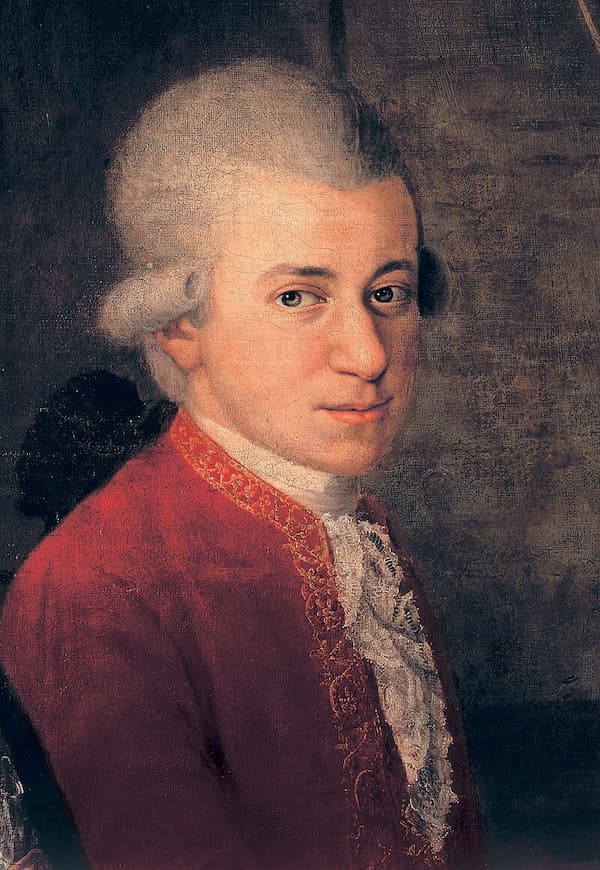
Croce: Mozart Family Portait (detail), 1781
Fittingly, we end the list with the composer who sported the greatest variety of nicknames – and proper names – in his lifetime. Mozart was formally baptised in Latin as “Joannes Chrysostomus Wolfgangus Theophilus Mozart” on the 28th of January 1756, the day after his birth, at St. Rupert’s Cathedral in Salzburg.
Following the custom of the Catholic Church, Mozart’s first two names are drawn from the saint’s day of his birth, in this case St. John Chrysostom, “Chrysostomus” meaning “golden mouth.” “Wolfgang” came from Mozart’s maternal grandfather, and “Theophilus” from his paternal grandfather. Interestingly, “Theophilus” comes from Greek and means “lover of God” or “loved by God,” and it is from this that Mozart came to be called by the Latin version, “Amadeus,” or the German, “Gottlieb.”
Mozart worked across cultural borders and was linguistically flexible and very playful about his own name. As such, Mozart would toy with Italian and French, signing letters with “Amadeo” and “Amadé.” He loved to be facetious and would sign letters with purposefully incorrect Latin. Indeed, the popularity of referring to Mozart as “Wolfgang Amadeus” was a largely posthumous and Romantic-era trend, as Mozart never signed a single document “Wolfgang Amadeus Mozart” – the closest thing to this that survives in record being a silly mock-Latin signature, “Wolfgangus Amadeus Mozartus.” He also used his names backwards for fun: “Mozart Wolfgang” and “Trazom.”
Friday, July 18, 2025
In Memory of the Past: Goethe’s ‘Erster Verlust’
by Maureen Buja
| Erster Verlust | First Loss |
| Ach wer bringt die schönen Tage, | Ah, who can bring back the beautiful days, |
| Jene Tage der ersten Liebe, | Those days of first love, |
| Ach wer bringt nur eine Stunde | Ah, who can bring back even one hour |
| Jener holden Zeit zurück! | Of that lovely time! |
| Einsam nähr’ ich meine Wunde | Lonely, I nurse my wound |
| Und mit stets erneuter Klage | And with ever-renewed lament |
| Traur’ ich um’s verlorne Glück. | I mourn for lost happiness. |
| Ach, wer bringt die schönen Tage, | Ah, who can bring back the beautiful days, |
| Jene holde Zeit zurück! | That lovely time! |

Joseph Karl Stieler: Johann Wolfgang von Goethe at age 79, 1828 (Neue Pinakothek)
Johann von Goethe (1749–1832)’s poem entitled ‘Erster Verlust’ (First loss) was first written in 1785 for his Singspiel Die ungleichen Hausgenossen (The Unequal Housemates), intended to be an aria for the Baroness, in Act II. The play was never completed, sidetracked, perhaps, by Goethe’s plans for his upcoming Italy trip. Luckily, he salvaged the poem (and two others) and included them in his Schriften of 1789. For the Schriften printing, Goethe wrote stanzas 2 and 3 anew.
Because of its small size and simple expression, the poems became a favourite of many composers, with some 50 setting it to music. We will look at the song and its setting over the century from 1813 through 1919. In this 8-line poem, Goethe expresses that painful memory of what was lost when one’s first love is no longer your love. There’s no idea of death, but rather hints of decisions made, time lost, and a mourning for the past.
Carl Friedrich Zelter (1758–1832) was one of Goethe’s favourite composers and became the poet’s musical advisor. He was a detailed chronicler of musical events of his time, and his letters are a prime source of information about significant events, such as the famed 1812 meeting of Beethoven and Goethe. Organised by Bettina Brentano, the two men met in the Bohemian spa town of Teplitz. As expected, they did not agree with each other’s self-assessment: Beethoven thought the poet too loving of the court atmosphere, and Goethe thought the composer had ‘an absolutely uncontrolled personality’. Goethe was 63 years old and Beethoven a mere 42.
Zelter wrote over 200 lieder, 75 of them to texts by Goethe. He detailed his thoughts on lieder writing in a letter to the composer Carl Loewe: the text must take priority, the strophic song is to be preferred to ‘absolute through-composing’, and the accompaniment must stay in the background.
Goethe, for his part, had his musical demands, the primary of which was that the music should support the poet’s words. This led Zelter to write music that was plain and strophic, even when the textual manner was more emotional. The music serves the poet’s words, and we can understand why Goethe was so taken with him. Famously, Goethe preferred Zelter’s setting of the poem Erlkönig, rather than the more dramatic setting by Schubert that is so well known today.
The song was published in 1813 as part of Zelter’s collection of 48 sämmtliche Lieder, Balladen und Romanzen; the four-volume collection was in its second edition by 1816.
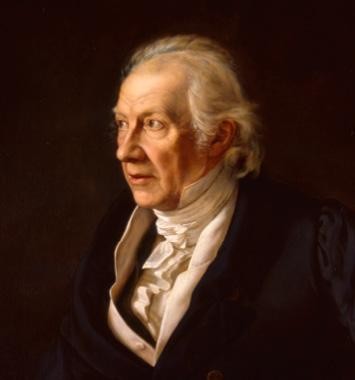
Carl Begas: Carl Friedrich Zelter, 1827 (Sing-Akademie zu Berlin)
Franz Schubert (1797–1828) picked up the text in 1815 and made it part of his Op. 5 collection, setting it in a precise and concise manner, and reserving his emotion for the last word of the 2nd stanza, ‘Wunde’ (wound). The minor-key setting is full of wistful memory and desire.
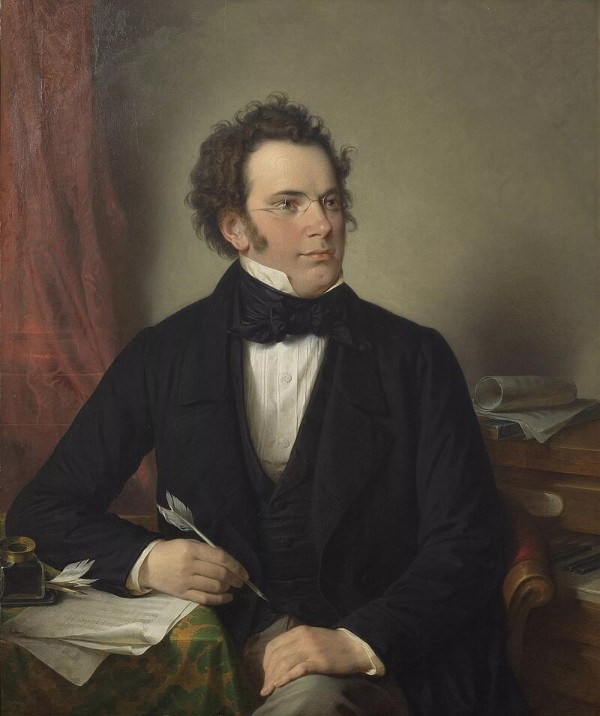
Wilhelm August Reider: Franz Schubert, 1875 after a 1825 watercolour (Vienna Museum)
Bohemian composer Václav Jan Křtitel Tomášek (1774–1850) led the musical world of Prague in the first half of the 19th century. He was the central point of the Mozart cult in Prague, and his fame spread through his lieder and piano compositions. Of his 63 lieder, 41 are settings of Goethe, and Goethe made a point of telling Tomášek in 1822 how much he approved of Tomášek’s work.
Tomášek met the 73-year-old poet in the Bohemian town now called Cheb, and after discussing music, poetry and minerals (Goethe had a famous rock collection), the poet encouraged the composer to play for him. Goethe gave him a book of poetry, and the 48-year-old composer played his music from memory. It was after Mignon’s Sehnsucht that the poet exclaimed, ‘you have understood the poem’, and then went on to say that he could not ‘understand how both Beethoven and Spohr could so entirely misinterpret it and treat it as though it were an aria and not a Lied.’
Tomášek’s setting is full of simple declarations, less full of melancholic regret than we find in other settings. There is still the emphasis on ‘Wunde’, but the setting of the first work of the first and last stanza’s first word, ‘Ach’ (Ah), that seems to carry the sharp despair.
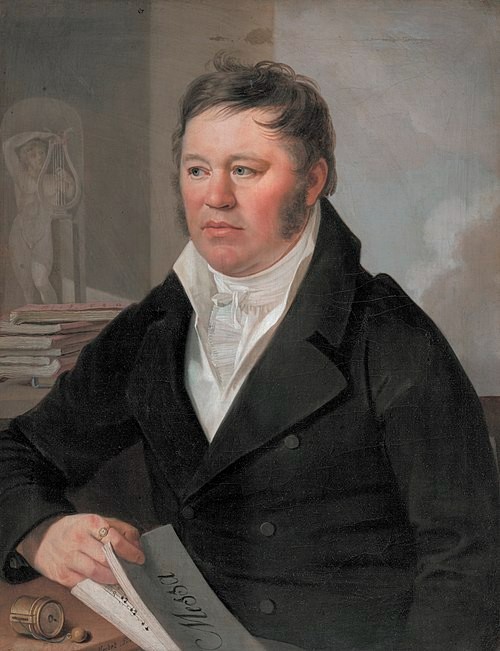
Antonín Machek: Portrait of the Composer V. J. Tomášek, after 1816 (Prague: National Gallery)
Felix Mendelssohn’s setting in 1841, as part of his Op. 99 collection Sechs Gesänge, expands the setting enormously, setting the same lines multiple times. The impression of the setting is somehow of deeper regret. The contrasting music for the second verse again puts emphasis on the word ‘wound’. The song concludes with decoration on the word ‘holde’ (lovely), bringing the beloved back one more time.
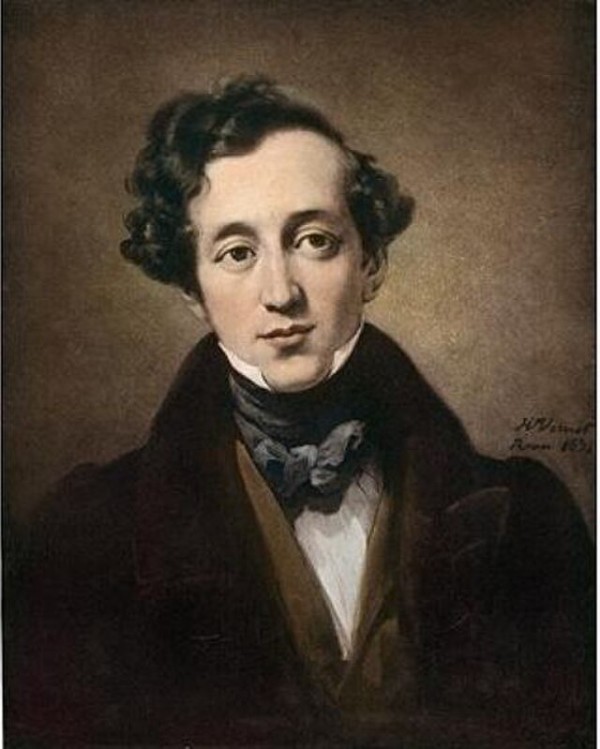
Horace Vernet: Felix Mendelssohn, 1831
Austrian composer Hugo Wolf (1860–1903) set the poem in 1876, as part of his Op. 9 collection, which set the poetry of Lenau, Goethe, and V. Zuzner. Wolf started writing music to the texts of Goethe at age 15, starting with 3 songs for male chorus.
When he set Erster Verlust, he was following the model set for him already by Reichardt, Zelter, Tomášek and Mendelssohn. Although this early setting, created in 1875 when he was just 15, shows much skill, we’re still dealing with the composer’s juvenilia. It is nothing compared to the lieder where he would show his genius.
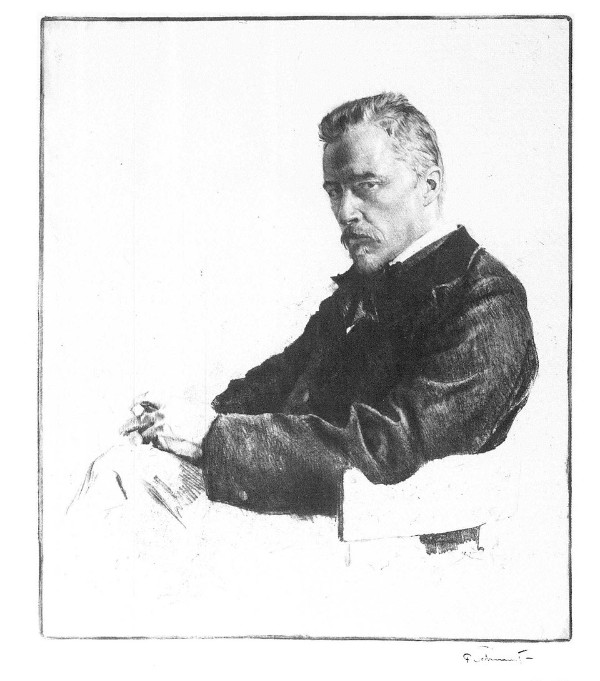
Hugo Wolf
Nicolai Medtner (1879–1951) published his op. 6 collection of 9 Goethe-Lieder between 1901and 1905. The majority of Medtner’s published songs are Russian, but Goethe was one of the most important German poets he set to music. Three of his Goethe collections resulted in him being awarded the Glinka Prize in 1909.
The lied was composed as a wedding present for his brother Emil and his bride Anna; however, the present had more than good wishes behind it. Nicolai had been forbidden marriage with Anna, and so his older brother Emil took his place; the marriage was never consummated. Eventually, Emil and Anna divorced, and then Nicolai and Anna were free to marry.
As a collection, it must be regarded as a wedding gift not to his brother but to his sweetheart, and a text such as Erster Verlust becomes particularly poignant. However, since his first lost love would eventually become his wife, this is one time when the story has a happy ending.
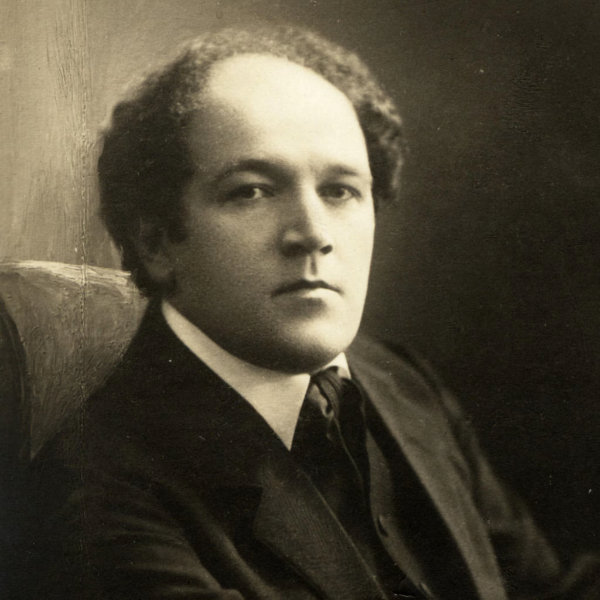
Nicolai Medtner
In his setting, Alban Berg (1885–1935) cuts off the last couplet of the poem, setting only the first two stanzas. The work was written in 1905 when he was just beginning as a composer. He worked with Arnold Schoenberg between 1904 and 1911 and was able to combine Schoenberg’s 12-tone technique with his own late-Romantic lyricism. He started with Schoenberg studying harmony, counterpoint, and music theory, and then, from 1907, composition. Even before studying with Schoenberg, he was a prolific composer, with some 80 lieder to his name. Schoenberg thought he was stuck in song, and over the years of study, made him work on his instrumental compositions.
Of all the Second Viennese School composers, he’s the one who has remained the most listenable. His operas remain in the repertoire.
The simplicity of this early song compared to what we know of his later works gives us true indication of what he learned from Schoenberg. Erster verlust was one of only three songs Berg wrote to a Goethe text, as he gradually started working with texts by more modern poets.
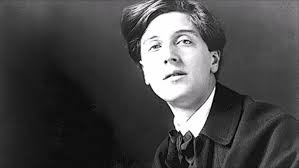
Alban Berg
Justus Hermann Wetzel (1879–1973) set Goethe’s text in 1919, as part of his Op. 3 Liederkreis collection. Over his long life, Wetzel composed over 600 songs of which fewer than 150 are still in the repertoire.
His style of clear melodic lines matched with an intense mood makes this song sound less like 1919 and more like 1819.
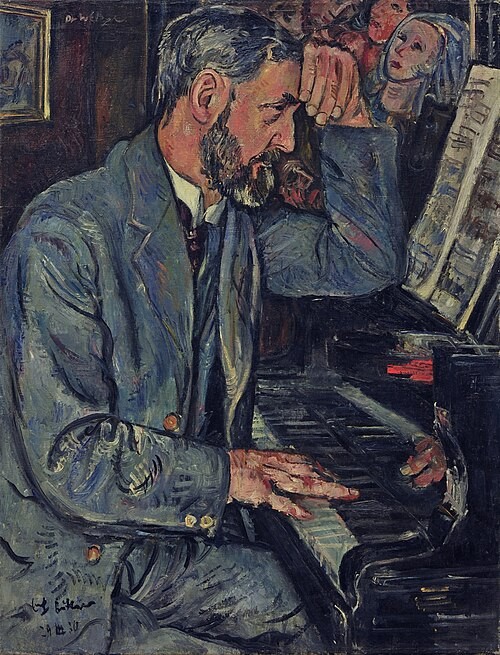
Erick Büttner: Justus Hermann Wetzel, 1930 (Berlin: Neue Natioanalgalerie)
Tracking the setting of this song for a century reveals an enormous amount about what composers read into the text and how tastes in lied writing circle around. Goethe’s insistence on the primacy of the text (as befitted him as the poet) could be seen as standing in the way of the composer’s need to create interpretations and filter for the material. Probably one of the most effective settings is Medtner’s, truly written for a lost love and given to the woman herself.
A composer takes his text and then decides what to emphasise (‘wunde’ or ‘Ach’) and how to place that emphasis. Realisation of the meaning of the text can happen in many ways. Not every composer wrote in a minor key, and not every composer read the poem the same way. A survey such as this gives us a deeper appreciation for the way certain composers (including Schubert) were able to find their way through such a seriously emotional path.
Friday, April 18, 2025
The 50th Schubertiade Anniversary Celebration Celebrating Gerd Nachbauer’s Founding Dream
In 2025, the Schubertiade festival celebrates its 50th anniversary, marking half a century of devotion to the music of Franz Schubert and the rich tradition of chamber music and lieder. What began as a modest series of concerts in the quaint Austrian town of Hohenems has blossomed into one of the world’s most prestigious and beloved musical events.
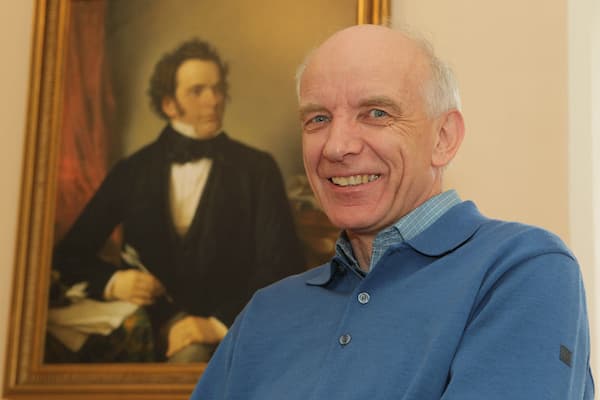
Gerd Nachbauer © Bernd Hofmeister
To be sure, the festival has grown from intimate gatherings into a global phenomenon, drawing tens of thousands of music lovers annually to experience its unique blend of exceptional performances and idyllic Alpine settings.
To celebrate this golden jubilee of enduring appeal and unwavering commitment to artistic excellence, Interlude spoke to Gerd Nachbauer, who founded the Schubertiade Hohenems alongside Hermann Prey in 1976.
Prégardien/ Drake: “Schubertiade Hohenems 2022”
Origins
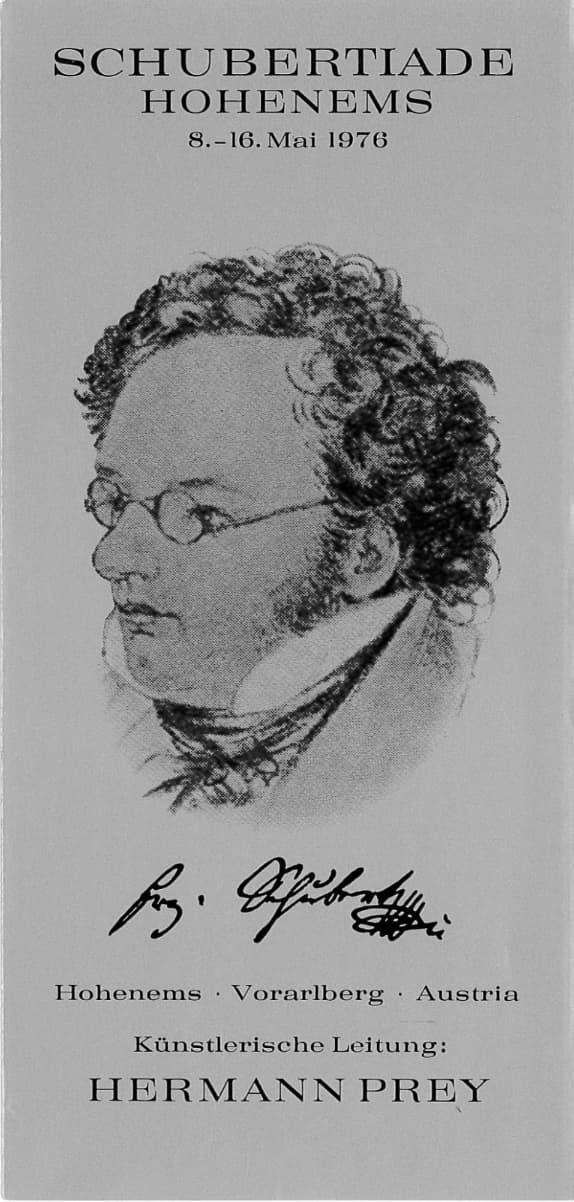
The first Schubertiade Hohenems, 1976
It all started with Gerd Nachbauer inviting Hermann Prey to participate in a small yearly festival situated in the town of Hohenems. As Nachbauer explained, “during the planning phase of a song recital scheduled for June 1975, Hermann Prey’s secretary Christian Lange suggested that this concert could serve as a test for a larger project associated with the names Prey and Schubert.”
This initial proposal for a concert linking Prey with Schubert’s music planted the seed that eventually blossomed into the renowned Schubertiade. The principle aim was to present Schubert’s complete oeuvre over a period of 12 years. After 2 years of planning, the first Schubertiade began on 8 May 1976 with a song recital by Hermann Prey accompanied by Leonard Hokanson.
Rennert/Johnson: “Schubertiade Schwarzenerg 2022”
Vision
The original vision foresaw the performances of the complete Schubert oeuvre in chronological order. For obvious reasons, this idea was not entirely practical nor feasible, and the primary emphasis remained on solo performances. In essence, the early years of the Schubertiade focused on simplicity and on communicating the intimacy of Schubert’s solo vocal compositions.
Nevertheless, the idea of bringing Schubert’s unknown or then-inaccessible compositions to the general public persisted. As Gerd Nachbauer noted, “a significant portion of Schubert’s compositions had remained under the radar,” and the Schubertiade now offered a vital channel to share these works with a wider audience. One aspect of that vision was to showcase Schubert’s music in larger concert halls, expanding beyond the traditional limits of smaller venues.
Youn/Karg/Bedenko: “Schubertiade Hohenems 2018”
Venue Choices
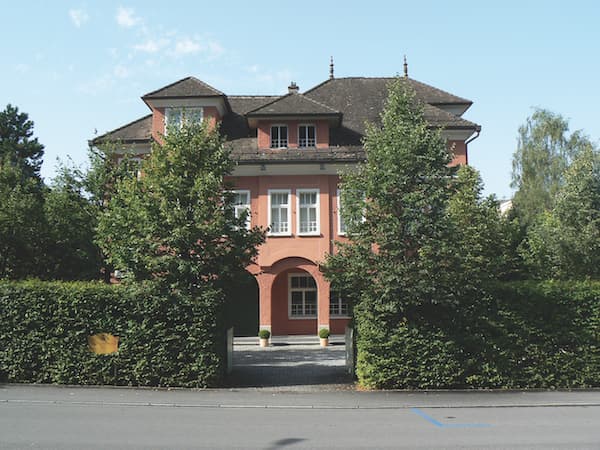
Markus Sittikus Hall in Hohenems, Austria
Currently, the Schubertiade is held in two unique locations, in Hohenems and Schwarzenberg. Establishing these venues, however, was no small task. The Markus Sittikus Hall, named after the Salzburg prince-archbishop Markus Sittikus von Hohenems, is housed in a building dating from 1913. It was completely renovated by the Schubertiade, and as Gerd Nachbauer explained, “on account of its acoustical qualities, it is now one of the world’s best halls for the performance of chamber music and Lieder.”
The idyllic village of Schwarzenberg has been an important venue for the Schubertiade since 1994. The “Angelika Kauffmann Hall” is named after the exceptional Neoclassical painter whose father brought her to their ancestral home in Schwarzenberg following her mother’s death. Kauffmann is one of only two female painters among the founding members of the Royal Academy in London, and the hall in her honour is built in a simple timber construction and also offers perfect acoustic conditions. In fact, its fantastic sound properties have been compared to London’s Wigmore Hall.
Arcayürek & Bushakevitz: “Schubertiade Schwarzenberg 2024”
Cultural Frame
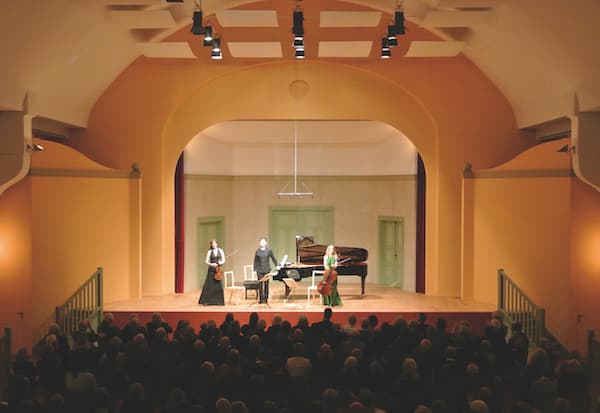
A chamber music concert in Markus Sittikus Hall
Over the last 5 decades, the Schubertiade has grown from an intimate celebration of Franz Schubert’s music into a renowned international event, drawing musicians, scholars, and enthusiasts to its locations in Hohenems and Schwarzenberg. It has evolved into an organic event of creativity fuelled by the dedication of Gerd Nachbauer, artists, and the community.
This organic development extends beyond the festival proper to a collection of museums that naturally complement the musical focus. Established by Gerd Nachbauer, the Schubert Museum offer immersive explorations of Schubert’s life, works, and reception, while the Elisabeth Schwarzkopf, Walter Legge, Stefan Zweig and Nibelungen Museums enrich the cultural tapestry with festival-related and local heritage.
Schubertiade 2025
Franz Schubert’s music, for Gerd Nachbauer, “goes straight to the heart, and conveys something deeply moving and emotionally resonant.” The 2025 Schubertiade is set to celebrate Nachbauer’s founding dream and Schubert’s enduring legacy.
Interlude will be on site for the Schubertiade Hohenems from 10-14 July 2025; please check back soon and often for updates, interviews, concert reviews, and festival-related activities.
Friday, April 11, 2025
Schubert – The Wanderer
by The Sokolover, Interlude
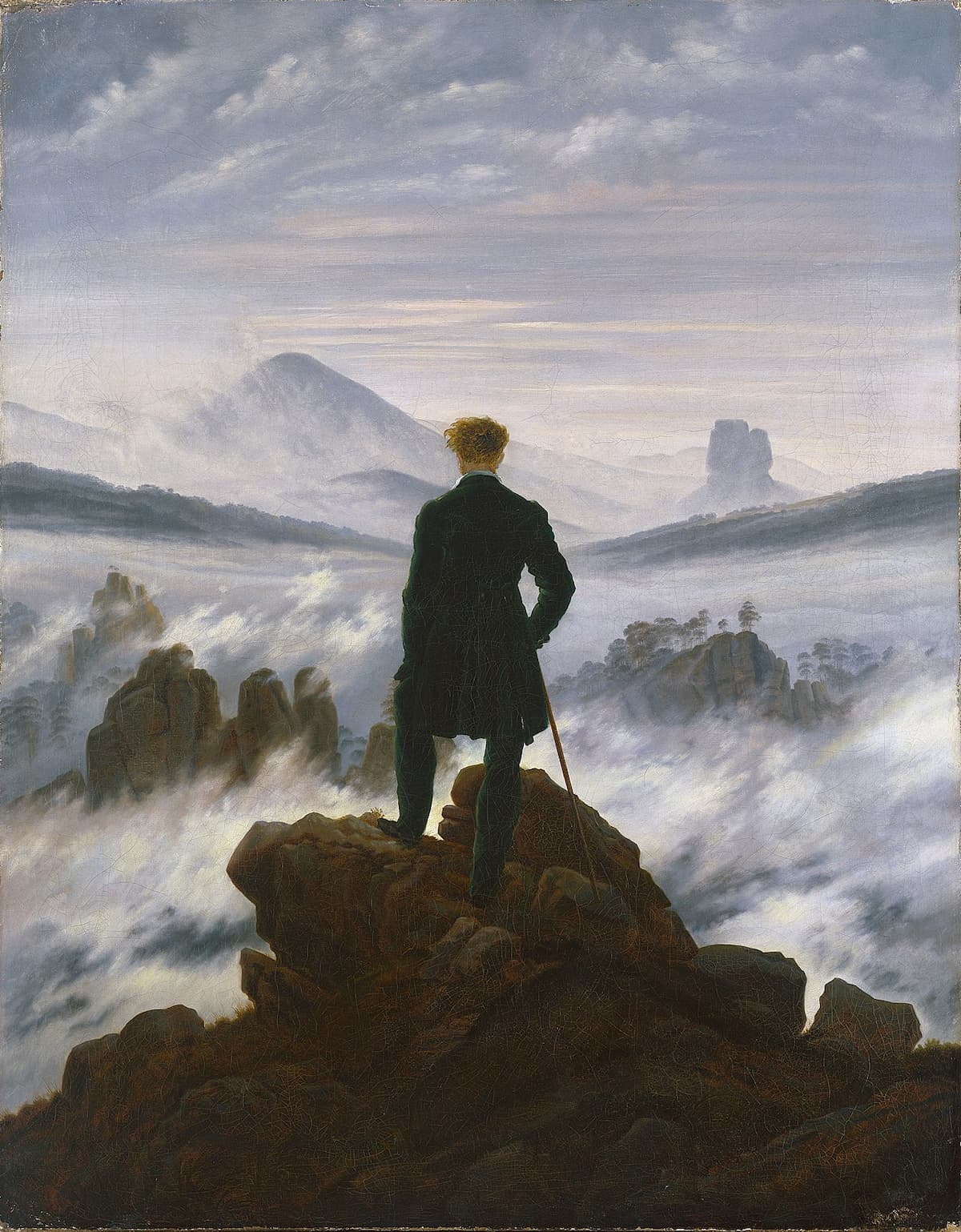
The Wanderer over the Sea of Fog (1818), by Caspar David Friedrich
It perhaps lacks the spirituality of Bach’s music, the sanguinity of Mozart, or the heroism of Beethoven. But that isn’t the point of Schubert’s music, for he never sought to transcend above or eschew human conditions. Instead, what we hear is a frank acknowledgement of our fragility and vulnerability.
His Impromptu Op. 90 No. 1 in C minor begins with a proclamation of G octaves. This recurs throughout the work and haunts us with a sense of threat and inescapable fate, bringing Erlkönig to mind. While the sections with duet singing (3:25, 6:45) contain probably the most gorgeous melody Schubert ever wrote (where else can such bittersweetness be found?), it only offers momentary consolation as the foreboding G octave repeats itself (4:05, 7:12). The Impromptu does end in C major, but are the conflicts resolved? Not really.
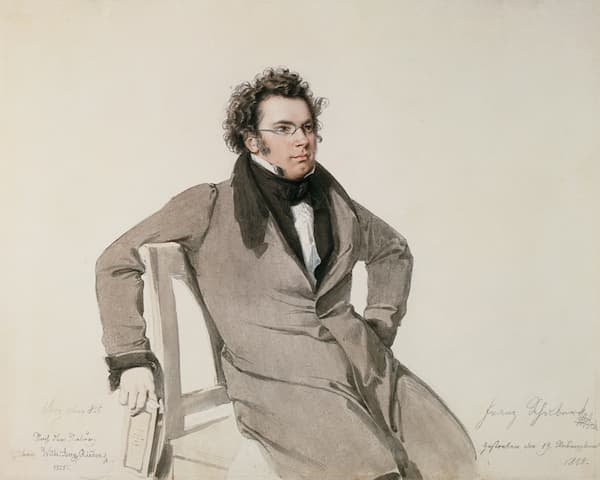
Franz Schubert
On the other hand, Impromptu Op. 90 No. 3 in G-flat major, a lied ohne worte in its effect, exudes such radiant warmth and embracing tenderness, undeterred by the troubled central section. What an exquisite combination of simplicity, intimacy and haunting beauty.
That said, and apparently, Schubert’s music isn’t all mellow or sentimental. Just listen to the stabbing pain and horror in his Der Doppelgänger, or the frenzied, demonic outcry that defies boundaries in Andantino from his Piano Sonata D. 959, both of which are almost psychologically traumatic and nakedly reveal another dimension of Schubert’s persona, and also that of human experience.
Central to Schubert’s aesthetics is a potent sense of solitude. He was a rootless loner who felt attached to nowhere, a poet of solitude, and a true wanderer – it could hardly be a coincidence that he wrote three Lieder on Der Wanderer (D. 493, D. 649, D. 870), not to mention the Winterreise. The poems on which these Lieder are based offer a unique sensibility to the psyche of a wanderer, or that of Schubert. Froh umgeben, doch alleine (there is joy all around, yet I am alone) – it couldn’t be better concluded.
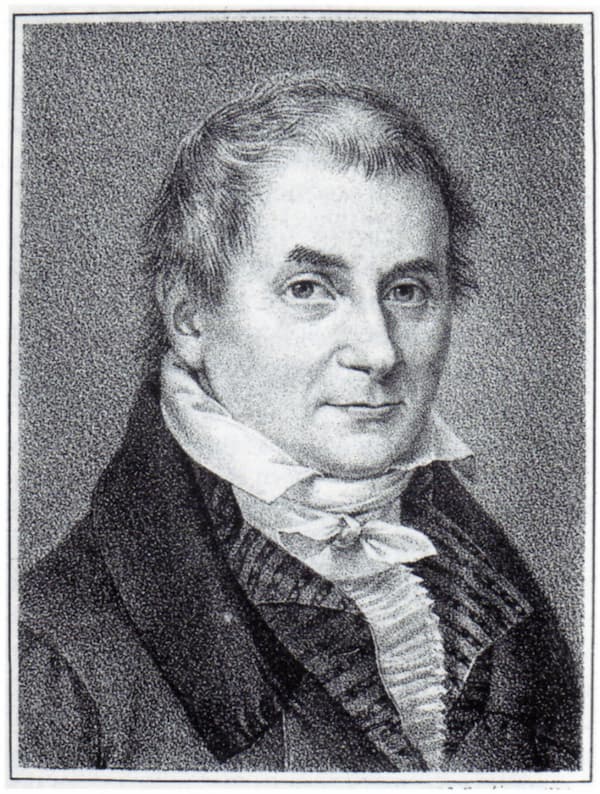
Georg Philipp Schmidt von Lübeck
| Der Wanderer (by Georg Lübeck) | The Wanderer (English translation by Richard Wigmore) |
| Ich komme vom Gebirge her, Es dampft das Tal, es braust das Meer. Ich wandle still, bin wenig froh, Und immer fragt der Seufzer: wo? Die Sonne dünkt mich hier so kalt, Die Blüte welk, das Leben alt, Und was sie reden, leerer Schall, Ich bin ein Fremdling überall. Wo bist du, mein geliebtes Land? Gesucht, geahnt und nie gekannt! Das Land, das Land, so hoffnungsgrün, Das Land, wo meine Rosen blühn, Wo meine Freunde wandeln gehn, Wo meine Toten auferstehn, Das Land, das meine Sprache spricht, O Land, wo bist du? Ich wandle still, bin wenig froh, Und immer fragt der Seufzer: wo? Im Geisterhauch tönt’s mir zurück: „Dort, wo du nicht bist, dort ist das Glück!“ | I come from the mountains; the valley steams, the ocean roars. I wander, silent and joyless, and my sighs for ever ask: Where? Here the sun seems so cold, the blossom faded, life old, and men’s words mere hollow noise; I am a stranger everywhere. Where are you, my beloved land? Sought, dreamt of, yet never known! The land so green with hope, the land where my roses bloom, Where my friends walk, where my dead ones rise again, the land that speaks my tongue, O land, where are you? I wander, silent and joyless, and my sighs for ever ask: Where? In a ghostly whisper the answer comes: ‘There, where you are not, is happiness!’ |
(Source: https://oxfordsong.org/song/der-wanderer)
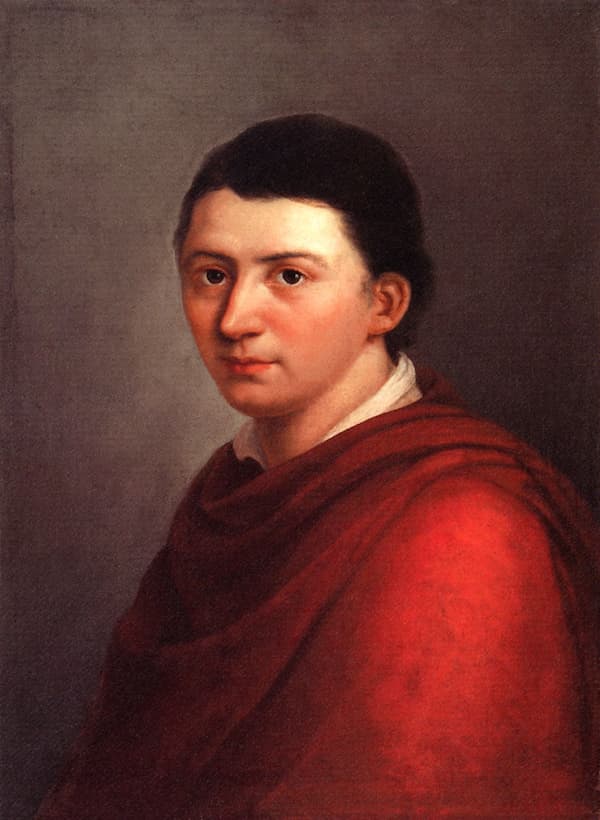
Friedrich Schlegel
| Der Wanderer (by Friedrich von Schlegel) | The Wanderer (English translation by Richard Wigmore) |
| Wie deutlich des Mondes Licht Zu mir spricht, Mich beseelend zu der Reise: „Folge treu dem alten Gleise, Wähle keine Heimat nicht. Ew’ge Plage Bringen sonst die schweren Tage; Fort zu andern Sollst du wechseln, sollst du wandern, Leicht entfliehend jeder Klage.“ Sanfte Ebb’ und hohe Flut, Tief im Mut, Wandr’ ich so im Dunkeln weiter, Steige mutig, singe heiter, Und die Welt erscheint mir gut. Alles reine Seh’ ich mild im Widerscheine, Nichts verworren In des Tages Glut verdorren: Froh umgeben, doch alleine. | How clearly the moon’s light speaks to me, inspiring me on my journey: ‘Follow faithfully the old track, choose nowhere as your home, lest bad times bring endless cares. You will move on, and go forth to other places, lightly casting off all grief.’ Thus, with gentle ebb and swelling flow deep within my soul, I walk on in the darkness. I climb boldly, singing merrily, and the world seems good to me. I see all things clearly in their gentle reflection. Nothing is blurred or withered in the heat of the day: there is joy all around, yet I am alone. |
(Source: https://oxfordsong.org/song/der-wanderer-2)
Looking back at his late piano sonatas, some would argue: isn’t the gaiety and exuberance in the finales of D. 959 and D. 960 undeniable? Well, it could be a self-affirmation in the face of impending demise, a delusional triumph against his fate, an imagined joy that didn’t belong to him – or a joy that finally belonged to him, but in another world.
Friday, January 31, 2025
Musings on Schubert
by Anson Yeung

Schubert at the Piano – Gustav Klimt (1899)
Schubert is probably the only composer who can create music that is even more heart-wrenching and disturbing in major keys than in minor keys. An example I would immediately think of would be his Klavierstücke No. 2 in E-flat major. Starting with a gentle and intimate atmosphere, it then transits into the tumultuous first trio and later the more poignant second trio in A-flat minor. There’s a moment where the music suddenly detours into A-flat major (a dominant seventh technically) for merely one bar and then returns to the original tonality. Compare 6:36 and 9:07 in the recording below – this never fails to give me goosebumps, as if there’s finally a gleam of hope, but it’s extinguished in a matter of seconds.
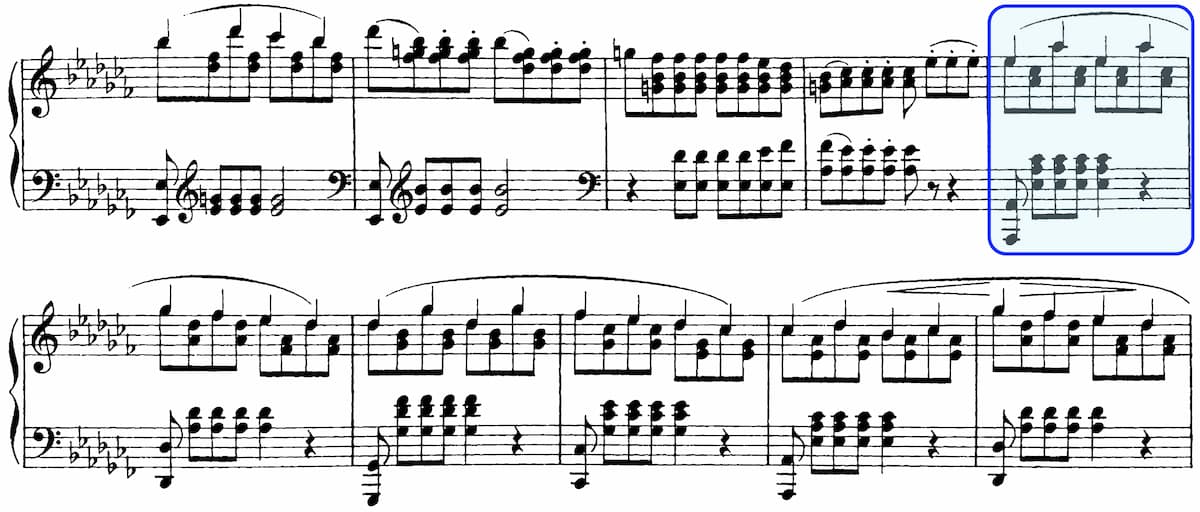
Figure 1
The bar highlighted in blue appears for the first time in A-flat minor.

Figure 2
This time it is in A-flat major but returns to the original tonality after one bar.
Schubert is always a complex figure, with his music oozing so much nostalgia, hope, loss, grief, frustration, and many more. All these emotions are what make human beings fragile, but at the same time, what make us human. His music is often suffused with bittersweetness, in the sense that the apparently more joyous moments are, in fact, reminiscences of the unattainable past, while the music often draws us back to the darker side as if an interrupted dream.
Paul Lewis illuminated Schubert’s emotional landscape with an uncompromising interpretation of his sonatas in Hong Kong. In the Sonata in A major, D.664, I experienced embracing warmth, a sense of relief despite tinges of sorrow, and the imagery of rustic scenes, with the third movement full of buoyancy and a dancing pulse. On the other hand, Schubert’s neuroses and anguish fully came through in the Sonata in A minor, D. 845, coupled with such abandon and immensely white-hot passion from Lewis.
In my interview with Paul Lewis, he aptly described the “lack of resolution” in Schubert’s music, with which I greatly sympathise. Schubert often brings up conflicts without offering an answer, leaving us in a state of ambivalence. That’s something that makes his music close to my heart – after all, not everything in the world has or requires a resolution or an answer. Unlike Beethoven, Schubert accepted his fate as it was, and such an acceptance is most evident in his late sonatas.
Chopin once said, ‘Bach is an astronomer, discovering the most marvellous stars. Beethoven challenges the universe. I only try to express the soul and the heart of man.’ We can perhaps draw a parallel here. Schubert neither explored the topics of divinity and religion nor attempted to fight against his fate. Instead, it is all about the deepest, often ineffable human emotions, which is probably why listening to his music can provoke such a probing ache.
As with Schubert’s music, this piece of musing (or nonsensical mumbling for some) shall come to an end without a resolution, which is paradoxically yet to be discovered in his music per se.